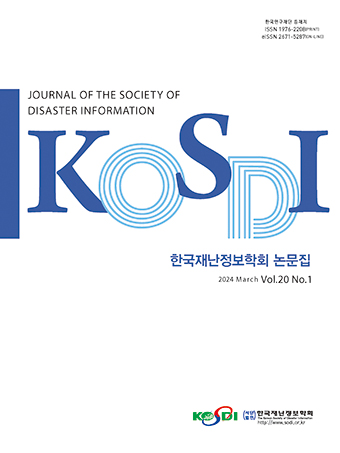Original Article
Abstract
References
Information
Purpose: Recently, a large social disaster has called for the need to diagnose social disaster safety, and the Ministry of Public Administration and Security calculates and publishes regional safety ratings such as regional safety index and national safety diagnosis every year. The existing safety diagnosis system uses equal intervals or normal distribution to grade risk maps in a uniform manner. Method: However, the equidistant technique can objectively analyze risk ratings, but there is a limit to classifying risk ratings when the distribution is skewed to one side, and the z-score technique has a problem of losing credibility if the population does not follow a normal distribution. Because the distribution of statistical data varies from indicator to indicator, the most appropriate rating should be applied for each data distribution. Result: Therefore, in this paper, we analyze the data of disaster indicators and present a comparison and suitable method for traditional equidistant and natural brake techniques to proceed with optimized grading for each indicator. Conclusion: As a result, three of the six new indicators were applied differently from conventional grading techniques
연구목적: 최근 대형 사회재난이 발생하면서 사회재난 안전도 진단에 대한 필요성이 요구되며 행정안전부에서 지역 안전지수, 국가안전대진단 등 지역의 안전도 등급을 계산하여 매년 공표하고 있다. 기존의 안전도 진단 시스템은 등간격 혹은 정규분포를 이용해서 획일화된 방법으로 등급화를 진행하여 위험지도를 작성하고 있다. 연구방법: 하지만 등간격 기법은 위험등급을 객관적으로 분석할 수 있지만 분포가 한쪽에 치우쳐있는 경우 위험등급을 분류하는데 한계가 있으며 z-score 기법은 모집단이 정규분포를 따르지 않으면 신뢰도가 떨어지는 문제가 있다. 지표별로 통계 데이터의 분포가 상이하기 때문에 데이터 분포별로 가장 적합한 등급화를 적용해야한다. 연구결과: 따라서 본 논문에서는 재난 지표의 데이터를 분석하여 각 지표마다 최적화된 등급화를 진행하고자 기존의 등간격 기법과 네츄럴브레이크 기법을 비교 및 적합한 방법을 제시하였다. 결론: 그 결과 기존의 등급화 기법과 다르게 적용된 것은 6새 지표 중 3개에 해당하였다.
- Cho, Y.B, Shin, K.C. (2013). "Study on development of indicators for measuring social value of social enterprise." Social Enterprise Studies, Vol. 6, No. 1, pp. 51-82.
- Hwang, H.S., Byun, B.S. (2011). " Building vulnerability index on climate change: Focused on Seoul metropolitan city." Journal of Environmental Policy and Administration, Vol. 19, No. 4, pp. 93-119.
- Kang, G.C. (2019). " A method and application of constructing an aggregating indicator: Regional descent work index in Korea." Journal of the Korea Academia-Industrial cooperation Society, Vol. 20, No. 2, pp. 153-159.
- Kim, H.J., Kim, J.S., Lee, S.H. (2019). "Spatial classification and inventory of adaptive strategy considering disaster vulnerabilities in the coastal area: Focused on Busan." Journal of The Korean Regional Development Association, Vol. 31, No. 3, pp. 231-251.
- Kim, J.E., Park, J.Y., Lee, J.H., Kim, T.W. (2019). "Socioeconomic vulnerability assessment of drought using principal componentanalysis and entropy method." Journal of Korea Water Resources Association, Vol. 52, No. 6, pp. 441-449.
- Kim, S.W., Shin, J.H. (2018). "A study on issues and improvements plan for national safety assessment." Journal of Korea Society of Disaster Information, Vol. 14, No. 3, pp. 334-342.
- Koo, W.H., Back, M.H. (2018). "A study on the consciousness survey for the establishment of safety village in disaster." Journal of Korea Society of Disaster Information, Vol. 14, No. 3, pp. 238-246.
- Lee, C.Y., Choi, J.H. (2020). "Socio-economic performance index of social enterprise by cities and provinces using Z-score: Focusing on social enterprises with job-provided type." Journal of Industrial Economics and Business, Vol. 33, No. 3, pp. 833-851. 10.22558/jieb.2020.6.33.3.833
- Publisher :The Korean Society of Disaster Information
- Publisher(Ko) :한국재난정보학회
- Journal Title :Journal of the Society of Disaster Information
- Journal Title(Ko) :한국재난정보학회논문집
- Volume : 17
- No :2
- Pages :319-328
- DOI :https://doi.org/10.15683/kosdi.2021.6.30.319




 Journal of the Society of Disaster Information
Journal of the Society of Disaster Information







